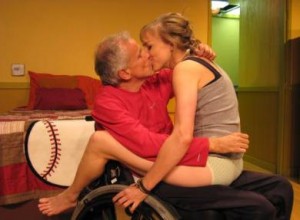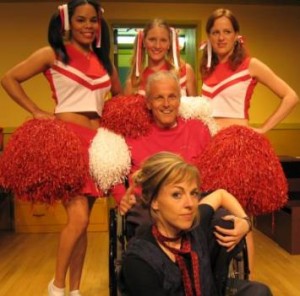RECOMMENDED
You know you’re in for something different at the theater when a quartet of
pom-pom bearing cheerleaders provide the pre-show announcements … as a
cheer. Follow that with a leading man who’s a real-life quadriplegic (Danny
Murphy of Farrely Brothers movies fame) and a quirky girl meets older boy plot
and you have The History Of Bowling, now playing at the NoHo Arts Center.
Murphy plays Chuck, a 32-year-old, or so he claims, though he may be shaving
a decade or so off his age, college student. He and pert 20something coed-
with-epilepsy Lou (played by Tara Samuel) meet cute in the college gym,
where each has decided to “play the cripple game,” which can be defined as
“taking advantage of one’s physical disabilities to attain something desired.”
In this case, what is desired is an exemption from the P.E. graduation
requirement. Unfortunately, their plan backfires when Phys Ed instructor Barnes
(Chris Scoles) assigns them to a special section where they are to write sports-
related papers during class time.
Mike Ervin’s script pokes fun at able-bodied people’s reactions to those with
physical handicaps. Chuck tells us that he was denied service at a shoe store
until he brought a doctor’s note. (Perhaps they were afraid that his feet might
explode.)
As a child, Chuck was a member of “Crippled Kids’ Bowling Buddies,” and he
suggests to Lou that they write their first paper on “The History Of Bowling.”
Meanwhile, shutterbug Lou wants to add Chuck to her series of photos of
nude models. (She takes pictures of friends and relatives doing what they’d
normally do (e.g. waiting for a train, vacuuming) … but naked.
Chuck’s roommate Cornelius (played by Lynn Manning, former Blind Judo
Champion Of The World) lost both his sight and his hearing when he “took a
brick in the head.” Corny is the ideal roommate for a frisky guy like Chuck,
because, as he tells Lou, “we could be doing it in the bed and he wouldn’t
know.” Cornelius’ twin disabilities lead to several very funny, if implausible,
sequences including one in which he and Chuck play poker with two separate
conversations going on simultaneously. (Corny recalls the joys of eating roadkill
possum while next to him Chuck talks of his feelings for Lou.) Later, Lou tells
Corny about her bisexual experiences all the while Corny keeps interjecting off-
topic remarks and quoting Baudelaire.
Samuel is perkiness personified as Lou, and it is easy to imagine her starring in
her own sitcom. Murphy has an ingratiating quality that serves as an antidote
to Chuck’s more acerbic moments. Deep-voiced Manning is very funny as
Corny, and Scoles does well in his moments as Coach Barnes. The cute and
athletic cheer team is composed of Kristin Arnold, Charlie Jacquo, Danyelle
Weaver, and Kimi Winkler. (Arnold and Winkler choreographed the cheers.)
Ervin is to be commended for writing an unapologetically politically incorrect
script which treats people with disabilities as just plain folks who can laugh at
their handicaps. His play would be even better if it went deeper into what
draws Chuck and Lou to each other and if we saw a more gradual progression
of their falling in love.
Dan Morski and Jay Vetter have created an extremely versatile set, which
director Sara Botsford has her four cheerleaders change, all the while
remaining in character, bouncing, skipping, moving set pieces with eager
delight. Tables become beds, ball racks become chests of drawers, lockers
become vending machines. Very cleverly conceived of and executed. (The
girls also help Murphy with his numerous costume changes.) Luke Moyer’s
lighting is, as always, excellent, and the between-scenes use of assorted
versions of Peggy Lee’s “Fever” (performed by numerous artists in numerous
styles) is another clever idea.
The History Of Bowling, provides many laughs and gives opportunities to actors
who might otherwise be overlooked in this town where physical perfection is
too often seen as a prerequisite for being cast. Though not entirely successful,
it is a cheer-inducing effort with much to recommend in it.
NoHo Arts Center, 11136 Magnolia Blvd, North Hollywood.
–Steven Stanley
March 21, 2008




 Since 2007, Steven Stanley's StageSceneLA.com has spotlighted the best in Southern California theater via reviews, interviews, and its annual StageSceneLA Scenies.
Since 2007, Steven Stanley's StageSceneLA.com has spotlighted the best in Southern California theater via reviews, interviews, and its annual StageSceneLA Scenies.







 COPYRIGHT 2024 STEVEN STANLEY :: DESIGN BY
COPYRIGHT 2024 STEVEN STANLEY :: DESIGN BY